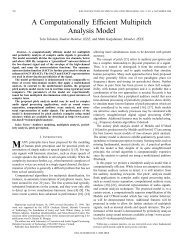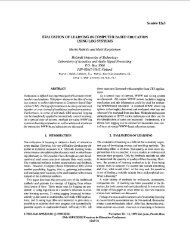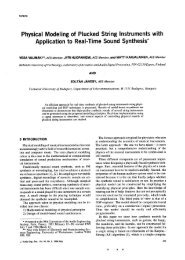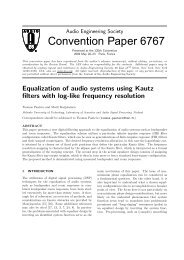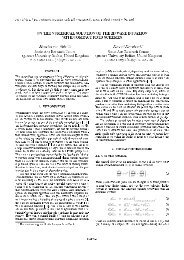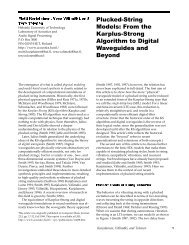Splitting the Unit Delay - IEEE Signal Processing ... - IEEE Xplore
Splitting the Unit Delay - IEEE Signal Processing ... - IEEE Xplore
Splitting the Unit Delay - IEEE Signal Processing ... - IEEE Xplore
Create successful ePaper yourself
Turn your PDF publications into a flip-book with our unique Google optimized e-Paper software.
constant with high precision when <strong>the</strong> fractional delay ischanged, unlike with previous designs. However, this comesat <strong>the</strong> cost of a worse phase delay response, which is particularlysevere with <strong>the</strong> 4-tap example (see Fig. A3b).O<strong>the</strong>r transition functions are not considered here. Theimpulse response of a raised-cosine transition function iseasily obtained by modifying <strong>the</strong> result of [12].4) General Least Squares FIR Approximationof a Complex Frequency ResponseThe smooth-transition-band-method reduces <strong>the</strong> error of <strong>the</strong>fractional delay filter in an advantageous way, but it has someshortcomings. First, <strong>the</strong> impulse response is still infinitelylong although it decays fast, and <strong>the</strong> truncation always causessome error. Second, <strong>the</strong> desired response must be definedexplicitly in <strong>the</strong> whole Nyquist band. While <strong>the</strong> method has<strong>the</strong> clear design advantage that <strong>the</strong> inverse Fourier transformcan be used to determine <strong>the</strong> coefficients explicitly, it never<strong>the</strong>lessforces approximation resources to be wasted outside<strong>the</strong> approximation band where <strong>the</strong>y are actually not needed.In principle, <strong>the</strong> delay filter with <strong>the</strong> smallest LS error in<strong>the</strong> defined approximation band is accomplished by defining<strong>the</strong> response only in that part of <strong>the</strong> frequency band and byleaving <strong>the</strong> rest out of <strong>the</strong> error measure as a "don't care"band. This scheme also enables frequency-domain weightingof <strong>the</strong> LS error; it results in <strong>the</strong> following error formulation(alternative formulations employing eigenfilter techniqueshave been introduced in [76] and [SS]).Fourier transform as H(e'w) and <strong>the</strong> error measure Eq. 24becomeswhere <strong>the</strong> superscript '*' denotes complex conjugation. Thiscan fur<strong>the</strong>r be put into <strong>the</strong> following formwhereE4 = h'Ph- 2hTpl + po (28)1po = - jW(o)IHjd(ejw)12 doZ Owhere <strong>the</strong> error is defined in <strong>the</strong> lowpass frequency band [0,an] only and W(o) is <strong>the</strong> nonnegative frequency-domainweighting function. Note that W(o) has nothing to do with<strong>the</strong> time-domain window w(n) (Eq. 22).We now derive <strong>the</strong> solution for a general H,d(e'"). Toformulate <strong>the</strong> solution in compact form, let us introducevector notation asThe error measure (Eq. 28) is quadratic with a uniqueminimum-enor solution that is found by setting its derivativewith respect to h to zero. This results in <strong>the</strong> following normalequationwhich is solved formally by matrix inversion, i.e.,h= [WO) WNIT (254for <strong>the</strong> filter coefficients and for <strong>the</strong> discrete-time Fouriertransform, respectively, and <strong>the</strong> matrixcos 0 ... cos(No) 1r 11 ... cos[N-1103where <strong>the</strong> superscript 'H' stands for <strong>the</strong> Hermitian operation,i.e., transposition with conjugation. Now we can express <strong>the</strong>Hence, <strong>the</strong> optimal solution is obtained by determining <strong>the</strong>integrals involved in Eqs. 29 (usually numerically) and solving<strong>the</strong> set of (N+ 1) linear equations (Eq. 32). The arithmeticcomplexity (i.e., <strong>the</strong> required number of multiplications andadditions) of a matrix inversion is in general proportional to(N + 1)3 so that <strong>the</strong> computational costs are considerablyincreased over <strong>the</strong> previous methods, where <strong>the</strong> coefficientsare obtained in explicit form. Fur<strong>the</strong>rmore, numerical problemsmay arise, particularly in narrowband approximation[60, 131. This is <strong>the</strong> price to be paid for <strong>the</strong> increased flexibilityof <strong>the</strong> design.The numerical problems are indeed regrettable as <strong>the</strong>general least squares approximation of a complex response38 <strong>IEEE</strong> SIGNAL PROCESSING MAGAZINE JANUARY 1996






